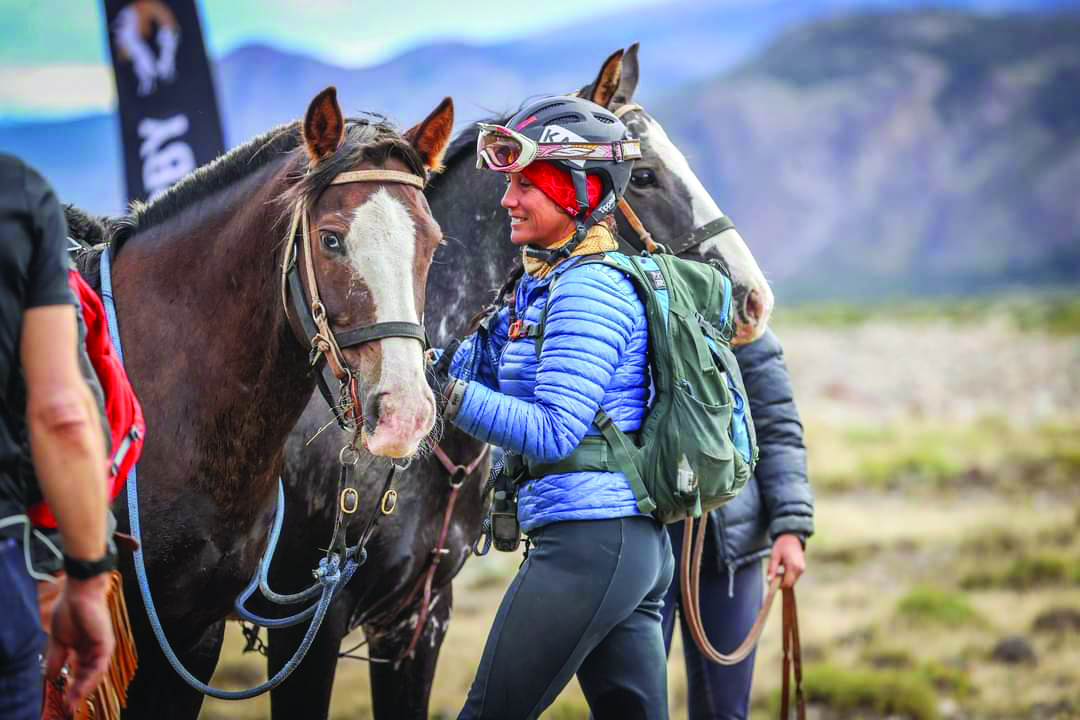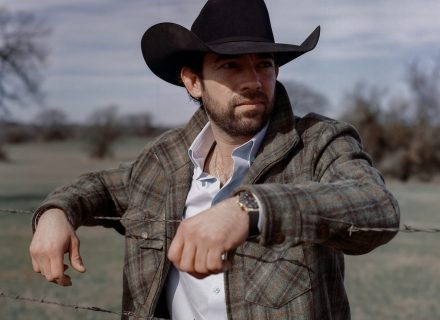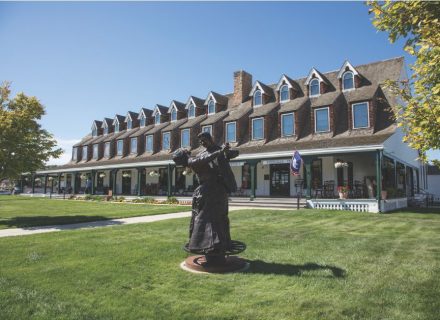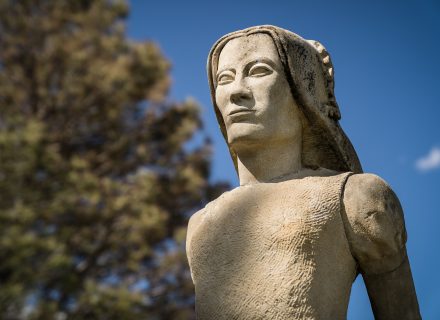We go for a wild ride with Kansas Carradine, one of the best horsewomen in the world.
The life of horsewoman Kansas Carradine, aka Circus Cowgirl, is all about riding and wellness and the role horses play not just in her quest for wellness for herself and her students, but, the wellness of the world.
We profiled Carradine, who is the daughter of David Carradine, in our October Women of the West issue on the heels of her once-in-a-lifetime adventure riding in the Gaucho Derby in Patagonia. It turns out she’s been on the back of a horse since she was a toddler, and in the years since, she’s done plenty of stunt riding and studying to inform her own equestrian expertise and teaching.
Whatever discipline she’s discussing or participating in, when it comes to wellness, personal development, and horse and rider, Carradine’s constant theme is compassion. “Compassion for themselves, their horses, and others,” she says. “I hope that they feel a real connection to their inner guidance and intuition. I want them to feel they can access inner ease, gratitude, and peace anywhere, anytime, irrespective of external circumstances.”
We talked at length to Carradine about her riding, the tools she relies on in horsemanship and life, and the horse-human relationship.
Cowboys & Indians: One of your foundational tools is HeartMath. Explain what that is.
Kansas Carradine: I was first introduced to HeartMath Techniques as a way to regulate my nervous system, to cope with depression and anxiety. I have used it privately since about 2003, and then started to apply the techniques with my horses, and it was a revelation.
HeartMath Tools are emotional self-regulation techniques that have been tested and backed by over 30 years of science and medical research. We learn how to synchronize the mind-body functions through the intrinsic cardiac nervous system, or “heart-brain.” There are lots of tools, but it all starts with tactical breathing — in through the heart and out through the heart — or chest area to switch from survival mode to a state of coherence or flow.
Co-regulation is a buzzword these days. HeartMath teaches us to regulate our autonomic nervous system. Horses are mammals, too, and when we learn about them, we learn about ourselves. I was attracted to helping improve animal welfare, and I learned that can be best achieved by helping humans regulate their emotions.
I teach with horses when they are available; however, I also teach courses on Zoom, and in classrooms outside of the equestrian industry completely.
C&I: Before we go vicariously to the wilds of Patagonia to talk about the grueling and glorious Gaucho Derby, tell us about why you see horses as key to sustainability.
Carradine: There are several ways in which I believe horses hold one of the many keys to sustainable solutions on the planet, and not just the obvious fact that the manure of horses is healthy and enriches our soil!
On a material level, horsepower has always been the ultimate “green solution” that uses less natural resources for transport and work. I saw this still in practice in Patagonia, where roads don’t exist and you can’t ride a quad or motorcycle in such rugged terrain.
Horsemanship increases the human capacity to problem-solve, develop nonverbal communication and leadership skills, increase coordination, and help us to learn to read body language.
Then there are the subtle ways. Horses are a mirror to the soul, connecting us to our spirit, and that in turn connects us to the heart of everything, where we develop more compassion, generosity, intuitive capacities, and gratitude.
It is universally recognized that people have somewhat of a nature deficit. We used to live in harmony with the natural world — its plants and animals — and with urbanization, many people in cities have never even spent time in dirt or near livestock. When we are in the presence of horses, they awaken all our senses. They make us more aware by default!
Many children I meet these days are afraid of horses. Large animals are unfamiliar and intimidating, and many folks also find the wilderness dark and foreboding. However, if we can learn again to feel safe in the presence of equines and develop that mastery that comes with experience and education, that translates to a feeling of ease and peace in many other domains, and we can have the courage to not only to experience the wilderness, but also protect it.
C&I: How did you learn to ride — beyond being tied to the horse at the age of 2?
Carradine: I started out trail riding with my cousin Ever and then was invited to do some Gymkhanas before the age of 7. At 7, I began formal English equitation, and then hunter-jumper.
C&I: How and when did you get into trick riding?
Carradine: I often answer this question with “I went to summer camp and never came home.” At the end of 5th grade, I went to Riata Ranch, three hours north of L.A. They had the most famous trick-riding school in America at the time. I was excited to learn more jumping and had wanted to do eventing, but at Riata Ranch, they were mostly cow-horse focused, and we rode Western. The first thing we did was swim horses in the river bareback, and then we spent every day trick riding, and I was hooked. I decided to move in with the owner and his wife for 6th grade, and I stayed until I graduated from 12th grade seven years later.
C&I: Fast-forward from your trick riding to your recent endurance ride. What made you want to do the Gaucho Derby?
Carradine: At first, the stories of endangering your horse made me not want to do it. It seemed too hard and risky. But then I learned more, and I felt drawn to connect with the land of the gauchos. I love being in the wilderness. I prefer to be in the mountains, on a trail, alone, and living a simple lifestyle, so to do it on the back of a horse was very attractive.
C&I: How did you prepare for it?
Carradine: So many things! Check out this blog on my website.
C&I: What did you say in your application that you think swayed them to accept you for the derby ride?
Carradine: Actually, I was a last-minute addition. I had about six weeks to prepare for what some folks take a year to train for. Warwick Schiller, who was registered, told me to call the event director, Eric Cooper, if I was interested in joining. I didn’t technically apply. Eric then looked at my profile picture, saw me standing up on a running horse, and asked if that was me. I said yes. And his response was, “Well, you can obviously ride.” Then he asked about my experience outdoors, which must have been enough, because then we quickly started talking about officially entering the race.
C&I: Tell us about the logistics of the Gaucho Derby.
Carradine: There were seven horse stations where you switch horses. You can be with your horse for as long as it takes to get to the next station, one, two, or three days. I rode seven horses in nine days — all of them were amazing! When you arrive at a horse station, you untack, turn them back to the herd, take time to do personal things (bathroom, eat, repack, repairs). Then you draw your next horse and go catch them and ride out. You stay with each horse for approximately 40 to 60 miles. Ride hours are roughly 8 a.m. to 6 p.m. each day. However, some days, it was adjusted, and we rode 12 hours a day. You are not allowed to ride past the allotted time, and are setting up camp (watering, grazing horses) before nightfall.
C&I: Do the organizers follow the participants with first aid/doctor/vet and food and water?
Carradine: There are 20 vet-check stations on the Gaucho Derby. At each vet check, there is a vet as well as a human medic. You carry all of your own food and purify water from rivers and streams on the journey. Some stations had a bit of food, but I am vegetarian, so I carried all of my own food. Sometimes their fire was useful to have hot water quickly, instead of me having to boil with my camping stove!
C&I: What were some of the most challenging aspects of the experience?
Carradine: Honestly, it was hard to see when riders were not compassionate with their horses, honoring them with the highest respect. There is an awakening horsemanship that is more compassionate, lighter, softer, more in the flow with our equine partners. Every relationship with horses is sacred. Misunderstandings occur, and often times, when an individual is pressured, the horse suffers as a result of the humans’ dysregulation. That is why I am so passionate about teaching emotional self-regulation — to help the horses not bear the brunt of a human’s error in judgement.
C&I: What kind of toll does that race take on the horses?
Carradine: Like any athlete, some handle it better than others. All my horses were lovely. Not all were leaders. Not all were the fastest, but they found an efficient way to navigate across the landscape and move in a healthy way. I believe humans sometimes interfere with the natural mechanics of horses, and that can create more unbalanced movement. I didn’t hear of any horses being injured, quite the contrary. These Gaucho Derby horses are more resilient than we can imagine. Because they are able to exist in a natural herd and have the freedom to move constantly in vast pastures, it allows them to take excellent care of themselves and stay healthy.
C&I: Tell me about a moment in the derby when you thought you might not make it.
Carradine: I never thought that I would not make it. I thought that I might have trouble arriving to a station in time before cutoff time but never was faced with a life-or-death moment. I prepared a lot, and I had a great experience, and I would do it again in a heartbeat. Being in a situation where I felt responsible for compromising my horses health, I was worried that I would get them in a dangerous situation, like a cliff face or sink bog, but that never happened. I was also worried that I didn’t water them or let them rest enough on hot days when we crossed mountains with dry lake beds. But these horses are used to covering tons of ground, and they are hardier than our domesticated show horses. I broke down crying on Day Three, thinking my horse was too hot, and he just proved me wrong and easily cantered home for the final 10 kilometers. I realized then that their capacity was greater than I could have ever imagined before.
C&I: You cover more than 300 miles, and that doesn’t even account for terrain changes. How did you dig down deep to keep going?
Carradine: I reread the reason why I was doing the derby to myself: to connect with the extraordinary gaucho horses and to understand the land and conservation efforts needed there. That was why I was interested. So the horses gave me focus and determination, while the natural environment provided inspiration and meaning. It was so beautiful and pure. I sang and said lots of prayers in a joyful sort of pilgrimage as I travelled! I never thought I wasn’t going to make it.
C&I: Tell us a little about the land, about Patagonia.
Carradine: Patagonia is unique, and unlike any other place I have been. I have been lucky to ride horses on every continent, save Antarctica. The southeastern Patagonia reminded me of the Eastern Sierras in California. The eastern slope of Yosemite, near Bridgeport and Bishop, California. The dry desert on the eastern slope, crossing into Nevada after all the moisture dumps on the Andes Mountain Range is very similar in Patagonia. Patagonia covers Chile, and three Argentinian provinces. I only saw the Santa Cruz region in Argentina. It’s special with the many beautiful turquoise glacial lakes, many endemic species. It’s vast and unspoiled. It has not changed much in the last century. I can’t wait to go back.
C&I: What did riding the Gaucho Derby teach you about yourself?
Carradine: I learned that I am most at home in the mountains on a horse! I cherish silence and beauty, and I don’t need much to make me happy.
C&I: About horses?
Carradine: Their abilities are far beyond what we know. They take care of humans as long as we get out of their way and trust them.
C&I: About the larger world?
Carradine: The wilderness is therapeutic on so many levels. Nature is restorative and abundant and will take care of humans as long as we slow down to appreciate the sunrises and sunsets and stop thinking so much. We don’t need much to survive. We do need each other.
C&I: What do you really want people to know about you?
Carradine: I’m just a little trick rider who followed her heart to a meaningful place. I didn’t know I would be able to come up with the money to do the derby, but I was supported by women, and it showed me that the whole universe wants to support our endeavors, especially when your motivation is for a bigger picture to help others.
Read our full feature on Kansas Carradine and get your copy of our October 2024 issue now.
PHOTOGRAPHY: Kathy Gabriel Photography





















